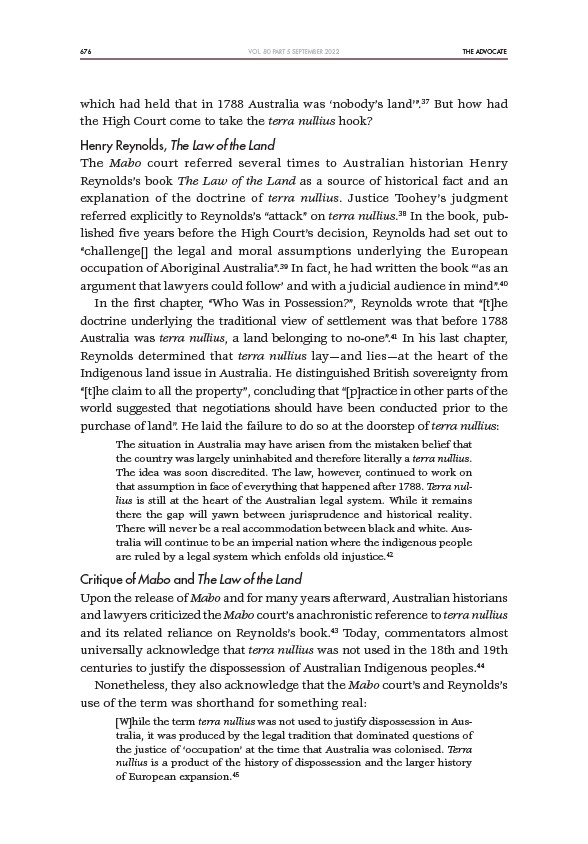
676 THE ADVOCATE
VOL. 80 PART 5 SEPTEMBER 2022
which had held that in 1788 Australia was ‘nobody’s land’”.37 But how had
the High Court come to take the terra nullius hook?
Henry Reynolds, The Law of the Land
The Mabo court referred several times to Australian historian Henry
Reynolds’s book The Law of the Land as a source of historical fact and an
explanation of the doctrine of terra nullius. Justice Toohey’s judgment
referred explicitly to Reynolds’s “attack” on terra nullius.38 In the book, published
five years before the High Court’s decision, Reynolds had set out to
“challenge the legal and moral assumptions underlying the European
occupation of Aboriginal Australia”.39 In fact, he had written the book “‘as an
argument that lawyers could follow’ and with a judicial audience in mind”.40
In the first chapter, “Who Was in Possession?”, Reynolds wrote that “the
doctrine underlying the traditional view of settlement was that before 1788
Australia was terra nullius, a land belonging to no-one”.41 In his last chapter,
Reynolds determined that terra nullius lay—and lies—at the heart of the
Indigenous land issue in Australia. He distinguished British sovereignty from
“the claim to all the property”, concluding that “practice in other parts of the
world suggested that negotiations should have been conducted prior to the
purchase of land”. He laid the failure to do so at the doorstep of terra nullius:
The situation in Australia may have arisen from the mistaken belief that
the country was largely uninhabited and therefore literally a terra nullius.
The idea was soon discredited. The law, however, continued to work on
that assumption in face of everything that happened after 1788. Terra nullius
is still at the heart of the Australian legal system. While it remains
there the gap will yawn between jurisprudence and historical reality.
There will never be a real accommodation between black and white. Australia
will continue to be an imperial nation where the indigenous people
are ruled by a legal system which enfolds old injustice.42
Critique of Mabo and The Law of the Land
Upon the release of Mabo and for many years afterward, Australian historians
and lawyers criticized the Mabo court’s anachronistic reference to terra nullius
and its related reliance on Reynolds’s book.43 Today, commentators almost
universally acknowledge that terra nullius was not used in the 18th and 19th
centuries to justify the dispossession of Australian Indigenous peoples.44
Nonetheless, they also acknowledge that the Mabo court’s and Reynolds’s
use of the term was shorthand for something real:
While the term terra nullius was not used to justify dispossession in Australia,
it was produced by the legal tradition that dominated questions of
the justice of ‘occupation’ at the time that Australia was colonised. Terra
nullius is a product of the history of dispossession and the larger history
of European expansion.45